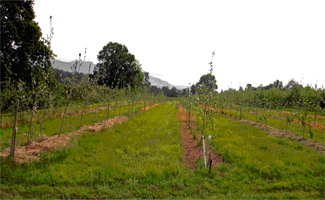Organic agriculture: a good option to be improved

In conventional agriculture, apple trees receive chemical fertilizer and tree-row vegetation is controlled with herbicides. Organic production of apples needs non-chemical alternatives. Organic fertilizers are available as manure or compost, but also as pelletized fertilizers obtained from animal and plant wastes. Different types of mulching or a mechanical control of weeds are alternatives to the use of herbicide. However, organic and conventional management of apple orchards may have a different effect on arthropod communities of ground-dwelling potential predators.
Within the framework of a project to estimate the multiple effects at the trophic levels of the systems of organic vs. conventional agriculture we compared the effect of two types of fertilizer (organic, chemical) and three tree-row management systems (straw mulching, tillage and herbicide) in the activity of four groups of predators (spiders (Araneae), ground beetles (Carabidae), rove beetles (Staphylinidae) and ants (Formicidae). These groups were chosen because of their indicator value and role as natural enemies of several apple tree pests like the codling moth (Cydia pomonella ). Predators were sampled monthly with pitfall traps in the same apple orchard during 2003, 2004 and 2005. A total of 4978 individuals were collected. The most abundant were ground-beetles (56.8%), followed by the spiders (20.7%), ants (14.8%) and rove beetles (7.7%).
Effect of tree-row management on abundance of different arthropods (mean captures per trap (n=36) over the whole sampling period). Green: mulching; brown: tillage; yellow: herbicide. Error bars correspond to standard errors. For each group, columns with the same letter are not significantly different; n.s.: non significantly different.
Tree-row management had a greater influence on predator catches than fertilizer treatment. Total predator catches were lower under the mulch. Mulching also reduced carabid abundance, but increased staphylinid catches. Tree row management also had a significant effect on biodiversity parameters. Species richness did not vary among treatment for the spiders, ants or total captures, but was higher on herbicide-treated plots for carabids and on mulched plots for staphylinids. Fertilizer application strategy only influenced the species richness of rove beetles, which was greater in the chemically-treated plots.
The results show that a change from conventional fertilizer to organic fertilizer of apple trees may be performed without much differential effects on predator activity-density or biodiversity. On the contrary, a change from herbicide treatment to mulching or mechanical weed control may be significant, depending on the taxonomic group. The conservation and enhancement of biological control by naturally-occurring enemies is considered a key point in the management of agricultural pests. A precise knowledge of the role that each taxon (including the species level) plays as a biocontrol agent is needed to favour its activity-density and the biological control of apple trees.
References
Miñarro M., Espadaler,X., Melero, V.X., Suárez-Álvarez, V. 2009. Organic versus. conventional management in an apple orchard: effects of fertilization and tree-row management on ground-dwelling predaceous arthropods. Agricultural and Forest Entomology 11: 133-142.

